Updated 06 Nov 2014
|
Landing on a comet in 2014
|
|
Landing on a comet in 2014 |
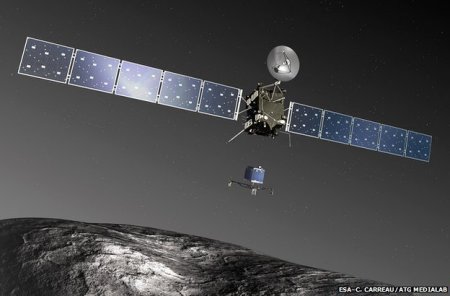
The story of PHILAE |
01
Philae was the name of an island in the Nile in Egypt.
|
02
In 1816 William Bankes discovered an obelisk at Philae.
|
03
William Bankes brought the obelisk home and stood it in his back garden
at Kingston Lacy in Dorset.
|
04
The obelisk had ancient Egyptian writing on its side.
|
05
This helped decipher Hieroglyphics on the famous Rosetta stone
|
06
The names Ptolemy and Cleopatra were found on both stones.
|
07
Linguistic genius Champollion deciphered Rosetta's hieroglyphics
with the help of the Philae obelisk.
|
08
The hieroglyph for CLEOPATRA is surrounded by a "cartouche"
|
09
The cartouches for PTOLEMY and CLEOPATRA on the obelisk
|
10
Champollion's notes on CLEOPATRA
|
11
PTOLEMY and CLEOPATRA
|
12
Similarities between the names
|
13
In 1969 2 Russians discovered a new comet by accident - 67P.
|
14
The Comet was discovered by (photo 2004):
(left)Churyumov and (right)Gerasimenko
|
15
In 1989 Europe decided to built a spacecraft (Rosetta) to orbit the new comet.
|
16
Rosetta had a little lander attached called "Philae"
|
17
Philae was designed to land on the comet
|
18
In 2004 Rosetta was launched.
|
19
Rosetta's route passed two asteroids on the way.
|
20
Rosetta then hibernated for 31 months, before waking up and sending
the signal to say:
"OK, I'm awake and ready" which takes 45 minutes to reach earth.
|
21
Imagine the joy of the team at Darmstadt at seeing that blip after 31 months!
|
22
So, in the same way that the obelisk helped decipher the Rosetta stone
hieroglyphics, space scientists hope Rosetta and Philae will help decipher
the comet 67P's ancient history, older than the Earth.
|
23
A protoplanetary disc, where comets are born.
|
24
06aug2014 Rosetta goes into triangular orbit round the strangely shaped
comet and sends back this picture (it takes 22 minutes)
|
25
25aug2014. The best 5 landing sites are chosen.
If one considers the comet to look like a rubber duck,
then three of the chosen potentials (B, I and J) are on the head.
Two are on the body (A and C). The dramatic neck region has been ruled out.
(A) interesting "body" site that will be attractive because it will afford
a view of both lobes
(C) another body site that features depressions, cliffs, hills and smooth
plains
(B) on the "head" and has a crater-like structure with a smooth bottom
(I) looks to have a lot of fresh material on its surfaces. Also on the head.
(J) the third head location, with interesting features and good lighting
conditions
The 4-km wide comet weighs about 10 billion tonnes.
Thats 300 kg per cubic metre. In water, it would float.
Its highly porous, and may have voids inside.
|
26
15sep2014.
Mission team select best two landing sites.
Primary (J) on the head of the duck and standby (C) on the body.
Landing still aimed at 11 Nov 2014.
|
27
03oct2014.
A selection of 4 landscapes, with cliffs, surface and a fortress.
A fine view of a jet issuing from the 'neck', on or just beyond
the horizon.
|
28
09oct2014.A boulder called "Cheops" surrounded
by a sea of small particles. The boulder is about 45 metres across.
|
29
18oct2014. Webmaster submits name "Kingston Lacy" in competition
for new name for 'J' as landing place for Philae on 67P.
|
30
04nov2014.Landing site 'J' is renamed 'Agilkia' after a public
competition of 8,000+ names in 7 days from 135 countries
|
In November 2014 a small spacecraft called Philae
will attempt to land on the surface of the comet 67P.
67P will be between Mars and Jupiter, and the mothercraft
Rosetta will then escort the comet to perihelion.
Rosetta will take 10 years to reach the comet after
it was launched in 2004 from French Guiana. European countries
have designed, built and paid for the mission, which is a follow-on
to their successful Giotto mission in 1986
The mothercraft and lander were named after the Rosetta stone and
Philae obelisk, which together deciphered the unknown Egyptian
hieroglyphic writing, and so the history of a mysterious civilization.
The obelisk was brought to Kingston Lacy
in Dorset by William Bankes in 1820, where the author saw
it and realized the connection with the comet.

This webpage has been compiled by  (who was 2 years
old when the first V2 was launched) out of respect for the engineers
who planned, designed and steered the mission over 25 years towards
a thrilling goal. (who was 2 years
old when the first V2 was launched) out of respect for the engineers
who planned, designed and steered the mission over 25 years towards
a thrilling goal.
For a good description of the History of the Mission by ESA, see:
ROSETTA'S TARGET: COMET 67P/CHURYUMOV-GERASIMENKO
|
From BBC News 06feb2004
The name Philae was proposed by Serena Olga Vismara from Arluno near Milan,
Italy.
Her prize for coming up with it will be a trip to Kourou to attend the
launch of the Rosetta mission.
It was on the island of Philae that an obelisk was found that had a
bilingual inscription including the names of Cleopatra and Ptolemy
in Egyptian hieroglyphs.
This provided the French historian Jean-Francois Champollion with the
final clues that allowed him to translate the hieroglyphs of the Rosetta
Stone and unlock the secrets of the civilisation of ancient Egypt.
|
Agilkia was one of the most popular entries – it was proposed by over
150 participants. The committee selected Alexandre Brouste from France as
the overall winner. As a prize, Mr Brouste will be invited to ESA’s Space
Operations Control Centre in Darmstadt, Germany, to follow the landing live.
|
005
A boulder called "Cheops" surrounded
by a sea of small particles (see Za
and See
discussion about what can be seen.
The boulder is about 45 metres across.
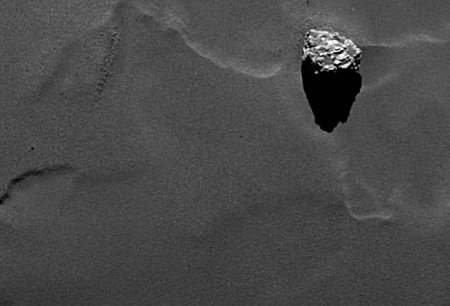
|
006
Close-up of "Cheops" with dimensions.
The shadow gives an idea of the shape of the
boulder, a bit like a pyramid.
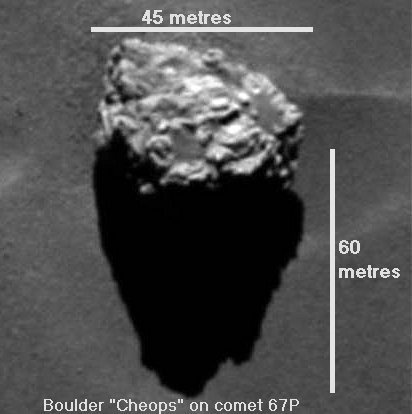
|
J
In 1969 2 Russians discovered a new comet by accident - 67P.
See more
& top
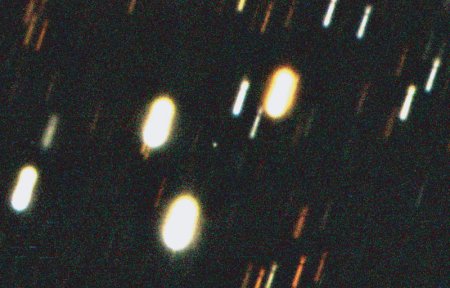
|
Zb
The Comet was discovered by (photo 2004):
(left)Churyumov and (right)Gerasimenko
top
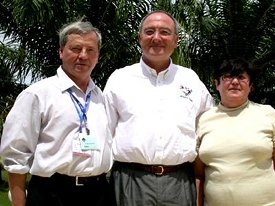
|
K
In 1986 European Giotto passed close to famous Halley's comet. See more
& top
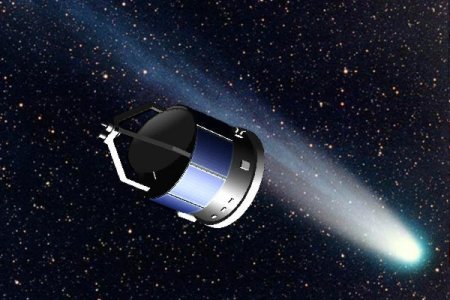
|
U
In 1989 Europe decided to built Rosetta to orbit the new comet. See more
& top
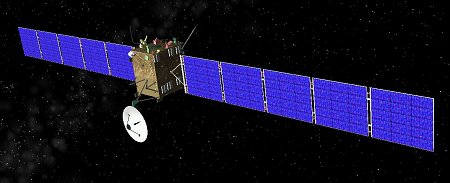
|
A
In 2003 Hubble had a closer look at the new comet.
See more
& top
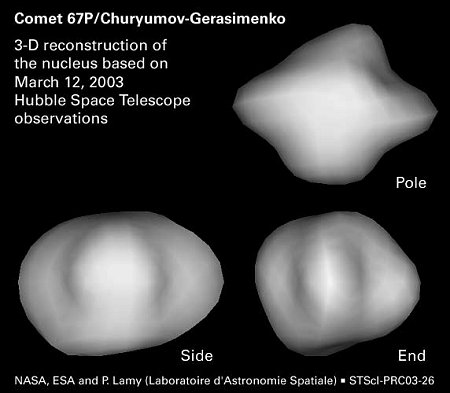
|
B
In 2004 Rosetta was launched.
See more
& top
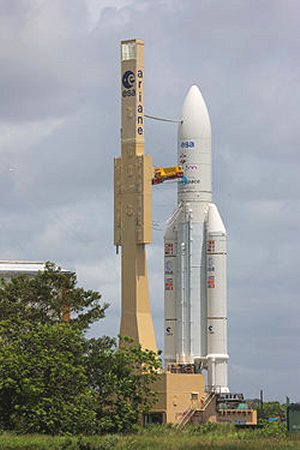
|
R
Rosetta's route passed two asteroids on the way.
top
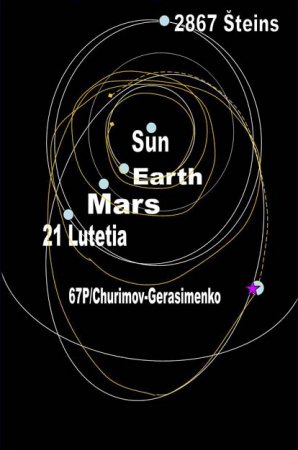
|
V
In 2008 Rosetta took a close-up of asteroid Steins.
The asteroid averages 5.3 kms across.
See more.
& top
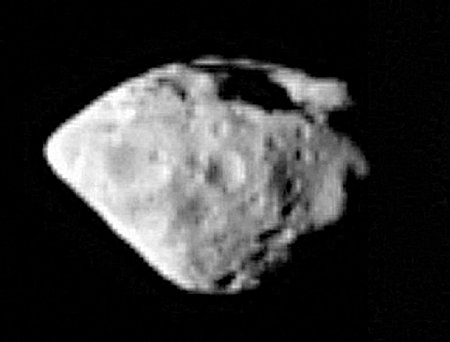
|
P
In 2010 Rosetta took a close-up of asteroid Lutetia.
The asteroid is 100 kms across.
See more.
& top
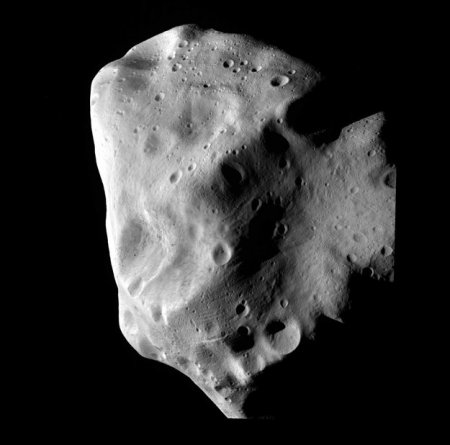
|
Px
Rosetta then hibernated for 31 months, before
waking up and sending the signal to say:
"OK, I'm awake and ready" which takes 45 minutes
to reach earth.
top

|
Py
Imagine the joy of the team at Darmstadt
at seeing that blip after 31 months!
top
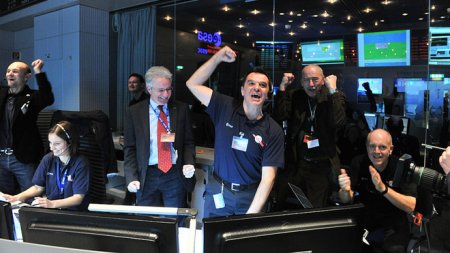
|
Y
Dr Matt Taylor, the European Space Agency's Rosetta project scientist
now has a tatoo of Rosetta, Philae and 67P pictured on his thigh!
top
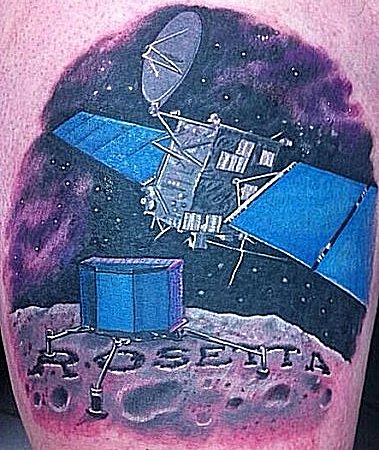
|
N
Rosetta had a little lander attached called Philae
top
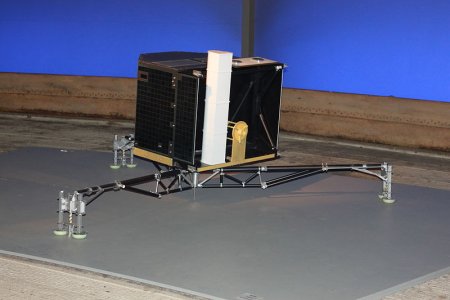
|
O
Philae was designed to land on the comet
top
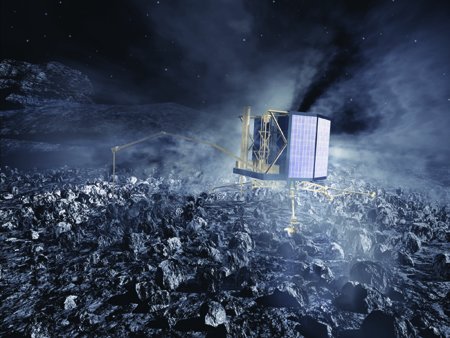
|
M
Philae was named after an island in the Nile in Egypt.
See more
& top
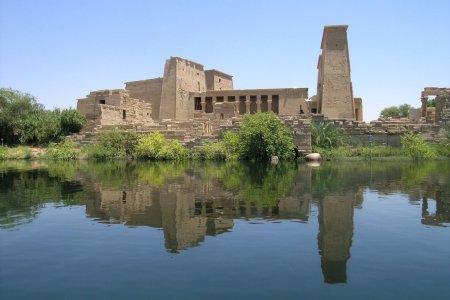
|
C
In 1816 William John Bankes discovered an obelisk
at Philae. See more
& top
|
Q
William Bankes brought the obelisk home and stood it in his back garden
at Kingston Lacy in Dorset. See more
& top
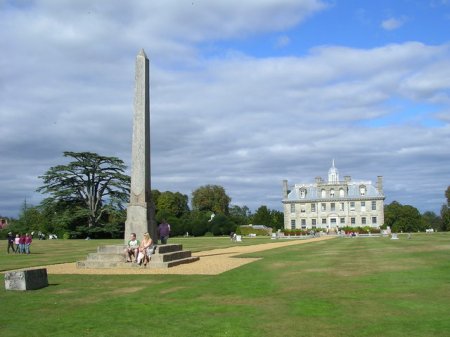
|
L
The obelisk had ancient Egyptian writing on its side
See more
& top
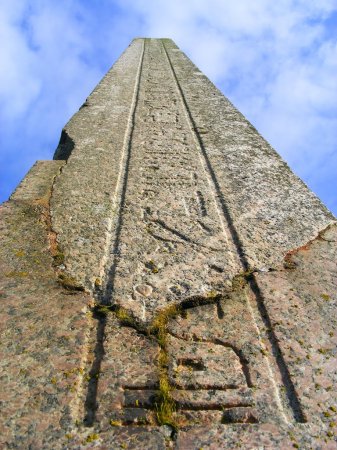
|
RTI
Recent study of the writing by Oxford University using
a system called
RTI makes clear writing
lost since 1824
See
more & top
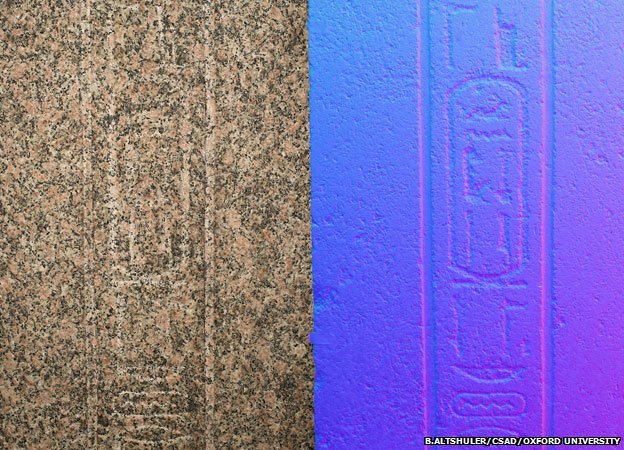
|
W
This helped decipher Hieroglyphics on the Rosetta stone
See more
& top
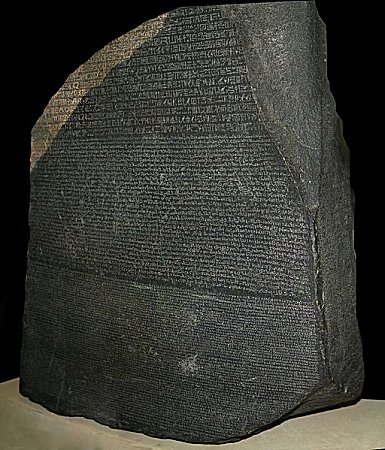
|
T
The names Ptolemy and Cleopatra were found on both.
top
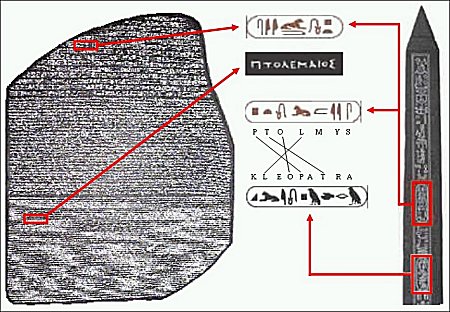
|
E
Linguistic genius Champollion deciphered Rosetta's
hieroglyphics with the help of the Philae obelisk.
See more
& top
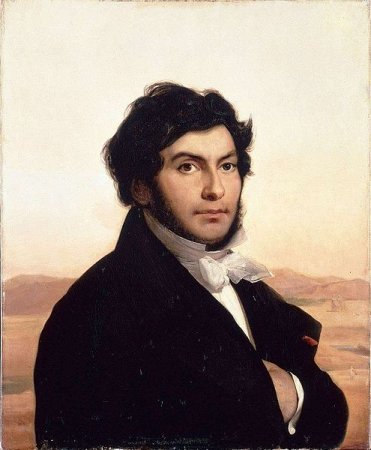
|
G
The hieroglyph for CLEOPATRA
top
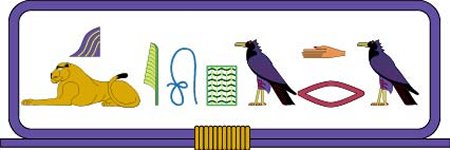
|
I
The cartouches for PTOLEMY and CLEOPATRA
top
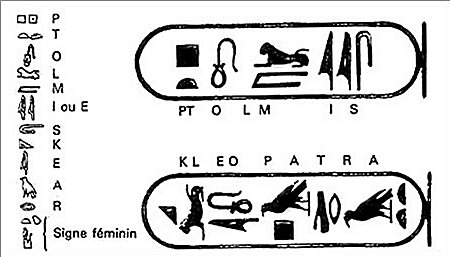
|
F
Chapollion's notes on CLEOPATRA
top
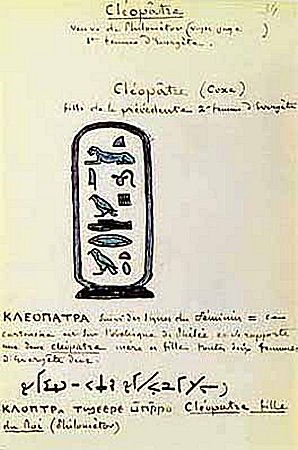
|
H
PTOLEMY and CLEOPATRA
top
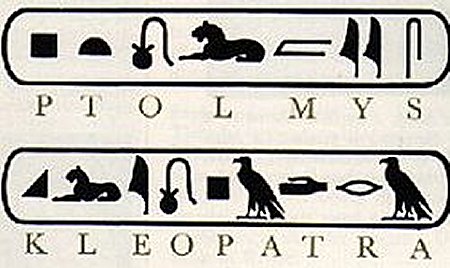
|
S
Similarities between the names
top
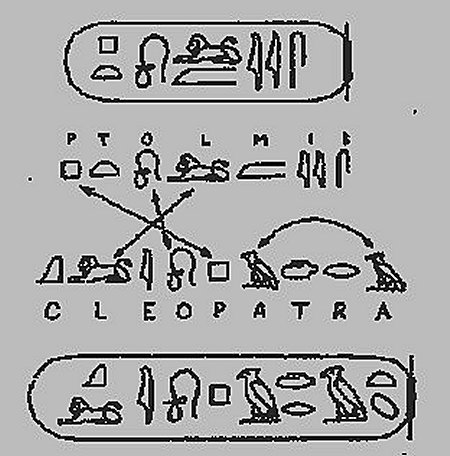
|
X
So, in the same way that the obelisk
helped decipher the Rosetta stone hieroglyphics,
space scientists hope Rosetta and Philae will
help decipher the comet 67P's ancient history,
older than the Earth.
See more
& top
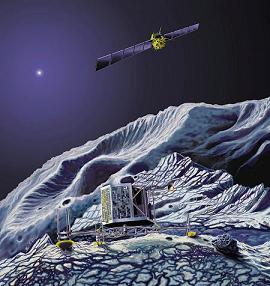
|
Alma
A protoplanetary disc, photoed by Alma radio observatory,
showing dust around a very young (1 my old) star collecting to form
young planets, asteroids and comets. Theory confirmed by
observation!
See more
& top

|
Za
07aug2014 Close-up of boulders, craters and steep cliffs,
taken from 130 kms.
3 months remain to decide on a landing place!
top
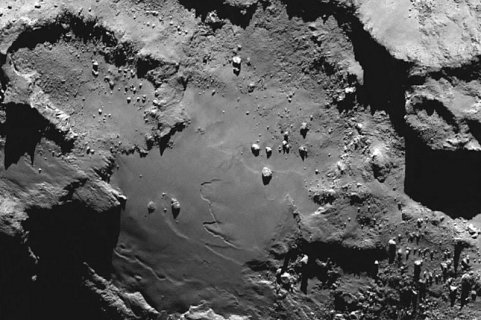
|
Z
06aug2014 Rosetta goes into triangular orbit
round the strangely shaped
comet and sends back
this picture (it takes 22 minutes)
top
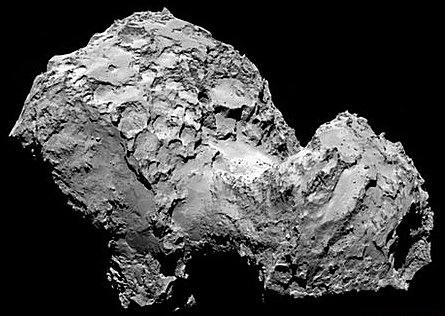
|
Zc
13aug2014. "Parallel linear features on upper, neck peppered with boulders
resting on a smooth underlying terrain, crater-like depressions on lower."
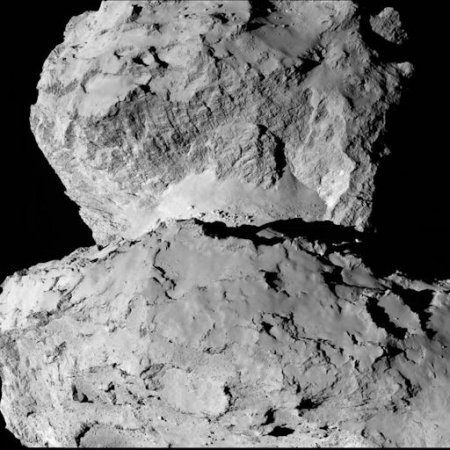
|
Zd
25aug2014.
The best 5 landing sites have been chosen.
If one considers the comet to look like a rubber duck, then
three of the chosen potentials (B, I and J) are on the head.
Two are on the body (A and C). The dramatic neck region has been ruled out.
(A) interesting "body" site that will be attractive because it will afford a view of both lobes
(C) another body site that features depressions, cliffs, hills and smooth plains
(B) on the "head" and has a crater-like structure with a smooth bottom
(I) looks to have a lot of fresh material on its surfaces. Also on the head
(J) the third head location, with interesting features and good lighting conditions
The 4-km wide comet weighs about 10 billion tonnes.
Thats 300 kg per cubic metre. In water, it would float.
Its highly porous, and may have voids inside.
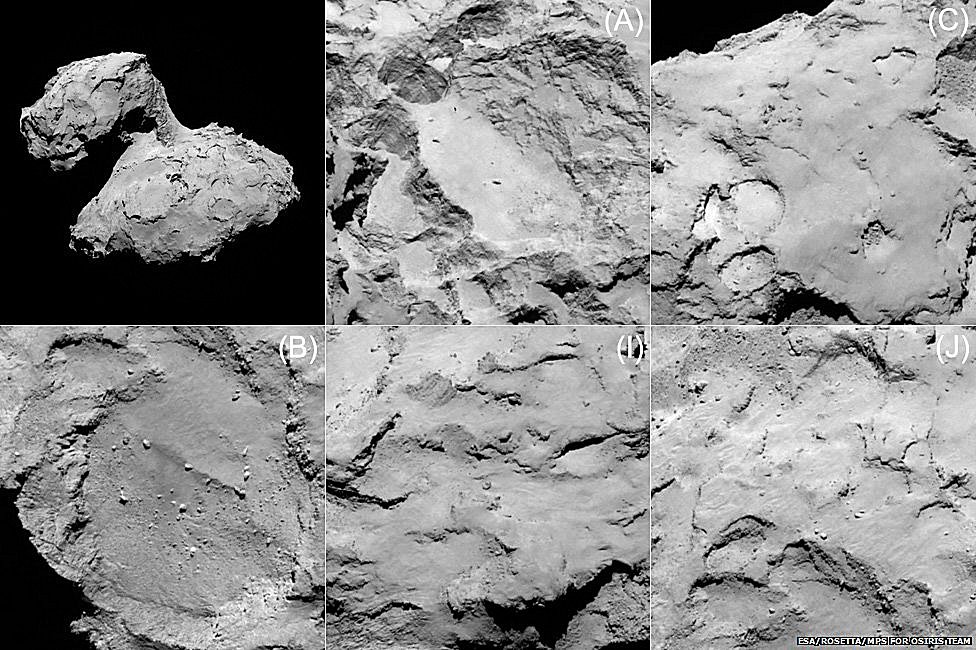
|
Ze 7sep2014
Rosetta solar wing, from Philae, comet behind.
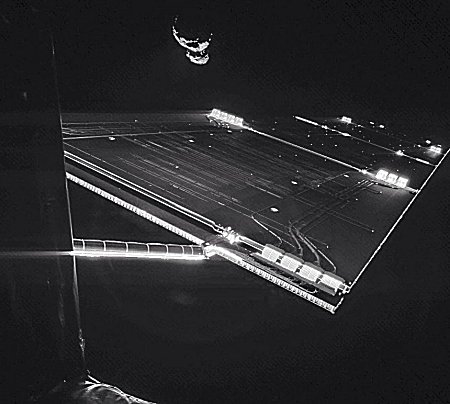 |
Zf 5sep2014
Cliffs & boulders & cracks, where is "least worse option" landing site?
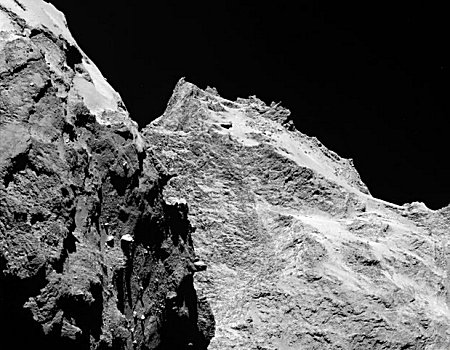 |
Zg 15sep2014
Primary landing site chosen as "J" on 'head of duck'.
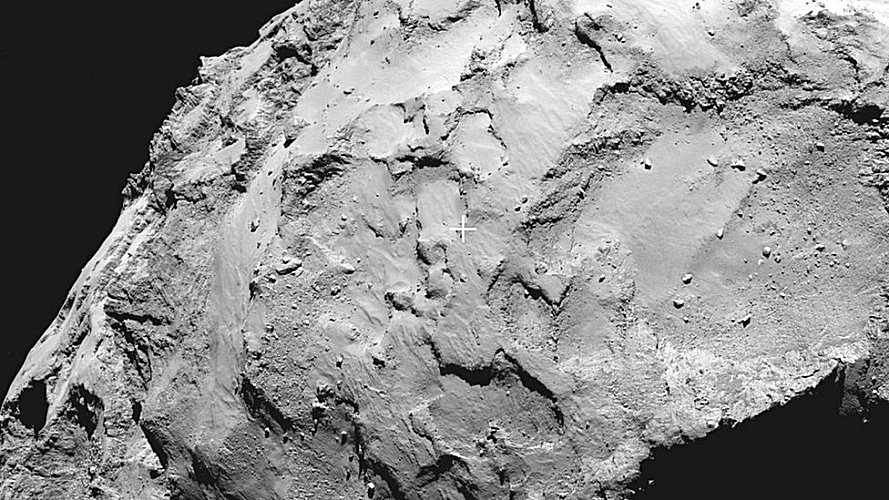 |
001 03oct2014
Fortress.
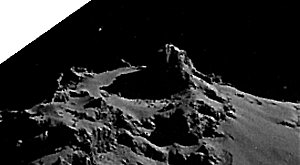
002 03oct2014
Cliffs.
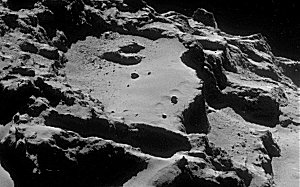
|
000 03oct2014
Jets rising from 'neck'.
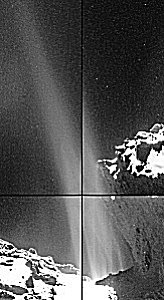 |
003 03oct2014
Surface.
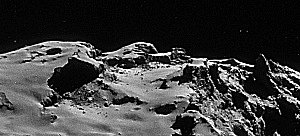
004 03oct2014
Fortress.
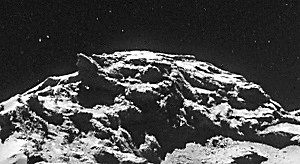 |
3748 The Isle of Philae.
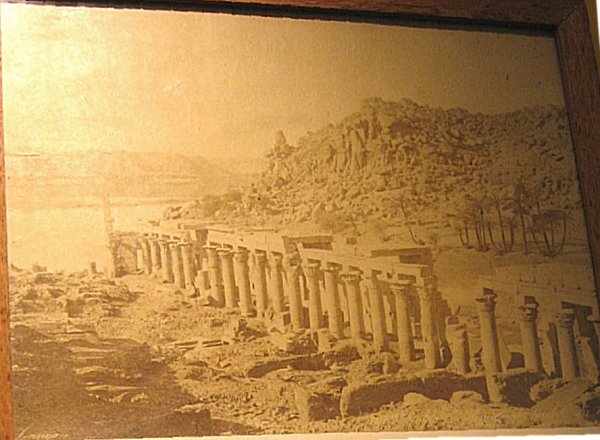 "Egyptian Obelisk removed from the Isle of Philae and erected
at Kingston Lacy, Dorsetshire in 1819.
"Egyptian Obelisk removed from the Isle of Philae and erected
at Kingston Lacy, Dorsetshire in 1819.
William John Bankes Esq MP eldest son of Henry Bankes MP caused
this Obelisk and the Pedestal from which it had fallen to be removed under
the Direction of
G. Belzoni in 1819 from the island of Philae beyond the
first Cataract and brought the Platform from the ruins of
Hierasykaminos
The Granite used in the reparation of this monument was brought
from the remains of Leptis Magna in Africa and was given for that
purpose by His Majesty King George IV.
The Inscription on the Obelisk and Pedestal record their
dedication to King Ptolemy Euergetes II and two Cleopatras his
Queens who authorized the priests of Isis in the isle of Philae
to erect them about about 150 years B.C. as a perpetual memorial
of Exemption from Taxation.
This spot was chosen and and the first stone of the Foundation
laid by
Arthur Duke of Wellington - August 17 - 1827"
|
3749 Island of Philae
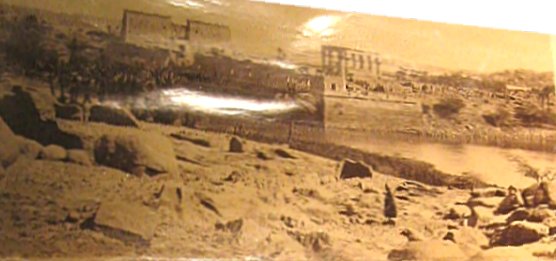
|
"Plan of the Island of Philae
A. Chapel of Nectambo, dedicated to Isis
B. Staircase still partially preserved, which was
the landing place leading up to the
Great Temple of Isis the principal building
on the Island.
The Greek Name Philae is a strange misnomer - In Egyptian it is Pilak
Length of Island 400 yards, Breadth 140 yards.
The whole surface of the Island is covered with ruins, but none are earlier
than the 30th Dynasty (361 B.C.)
Beginning ate the South end at the W. corner is the Chapel of (A)
Nectambo dedicated to Isis. This is the oldest ruin in the Island - In front
of it stood ten small Obelisks of which one remains broken in half.
N.B. One of the remaining Nine is at Kingston Lacy."
|
Received 18oct2014
Dear John Palmer,
Thank you for proposing a name for Philae's landing site.
The following details were registered:
Name: John Palmer
Email address: johnpalmer@eyemead.com
Country of residence: United Kingdom
I think Site J should be named: Kingston Lacy
Because: .......The obelisk from Philae with hieroglyphics,
which helped Champollion decipher the Rosetta Stone, was brought
to and erected at Kingston Lacy in Dorset, England with great
effort and expense by William Bankes in the 1820s, and can still
be seen there today by the public after 200 years. Kingston Lacy
house and grounds are today considered the "Crown Jewels" of the
UK National Trust and full of beautiful and interesting objects
and much history going back 2,000 years. Kingston Lacy would be
an ideal setting for an Exhibition about Rosetta (the spacecraft),
Philae (the lander), the Landing itself and what may be discovered
about the history of Comet 67P, and could be viewed by a great
number of people. Nearby are carparks, restaurants, facilties
and popular wooded walks and snowdrop displays in late winter.
Language: English
In any future correspondence please state this reference number: 2428.
For any questions regarding the competition you can contact us at
Rosetta Competition
The winner will be announced on 3 November 2014 on the ESA Rosetta
website: www.esa.int/rosetta
|
Kingston Lacy
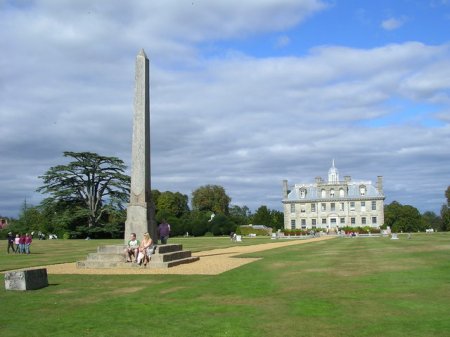 |
----------8-------------------------------
ESA Rosetta Mission @ESA_Rosetta 04 Nov
'Agilkia' was proposed by over 150 of you! Overall winner is Alexandre
Brouste from France. Congratulations and thanks to all! #NameJ
----------7-------------------------------
ESA Rosetta Mission @ESA_Rosetta 04 Nov
Say farewell to 'J' …and hello to Agilkia! @Philae2014’s landing site
has a new name! Full story: ow.ly/DNkZf #namej
----------6--------------------------------
ESA Rosetta Mission @ESA_Rosetta 03 Nov
Sorry @Philae2014 & all, jury needs 1 more day to pick winning name
for your landing site – so many great suggestions! #NameJ
----------5-----------------------------
DLR - English @DLR_en 03 Nov
Exciting times! MT @Philae2014: Today we find out the name of my
landing site on #67P. Hmmm. what will it be? Can't wait! #NameJ
----------4-----------------------
Philae Lander @Philae2014 29 Oct
.@ESA_Rosetta Wow! Over 8000 suggestions to choose from... I'm
sure it'll be a tough decision #NameJ
----------3--------------------
ESA Rosetta Mission @ESA_Rosetta 29 Oct
.@Philae2014 I heard there were over 8000 suggestions for #NameJ!
Final decision expected on Monday!
----------2-----------------
ESA Rosetta Mission @ESA_Rosetta 23 Oct
With landing site #NameJ contest now closed, the judges are very
busy looking through your thousands of suggestions – thank you!
----------1-------------------
ESA Rosetta Mission @ESA_Rosetta 16 Oct
Win a trip to @esa #67P landing event by suggesting name for
@Philae2014 landing site! ow.ly/CRfaI #NameJ pic.twitter.com/0214
ROc5IQ
-------------------------------
|
Farewell ‘J’, hello Agilkia
4 November 2014
|
The site where Rosetta’s Philae lander is scheduled to touch down on Comet
67P/Churyumov–Gerasimenko on 12 November now has a name:
AGILKIA.
The landing site, previously known as ‘Site J’, is named for Agilkia Island,
an island on the Nile River in the south of Egypt. A complex of Ancient
Egyptian buildings, including the famous Temple of Isis, was moved to
Agilkia from the island of Philae when the latter was flooded during the
building of the Aswan dams last century.
The name was selected by a jury comprising members of the Philae Lander
Steering Committee as part of a public competition run 16–22 October by
ESA and the German, French and Italian space agencies.
Agilkia was one of the most popular entries – it was proposed by over
150 participants. The committee selected Alexandre Brouste from France as
the overall winner. As a prize, Mr Brouste will be invited to ESA’s Space
Operations Control Centre in Darmstadt, Germany, to follow the landing live.
Although perhaps not quite as complicated as navigating Rosetta and Philae
towards the comet, the task of choosing a name was by no means simple.
More than 8000 entries from 135 countries were received in one week, showing
great creativity and cultural diversity.
“The decision was very tough,” says Prof. Felix Huber of the DLR German
Aerospace Center, chair of the Steering Committee.
“We received so many good suggestions on how to name Site J, and we were
delighted with such an enthusiastic response from all over the world. We
wish to thank all participants for sharing their great ideas with us.”
Participants proposed names in a variety of languages, both ancient and
modern; some were even in Esperanto. There were also some interesting
acronyms, curious sequences of digits, and onomatopoeiac words.
The entries covered a tremendous range of themes, from abstract concepts
to the names of places on Earth. As with the winning entry, many suggestions
echoed the Egyptian origins of Rosetta and Philae, named in recognition of
milestones in decoding hieroglyphics, the sacred writing system of ancient
Egypt.
Many names dated back to the history of our planet’s exploration, as those
journeys into the unknown are the natural forebears of Rosetta and Philae.
Mythological names from all over the globe were also proposed, including
gods and goddesses of water, fertility, life and creation, relating closely
to the fundamental themes investigated by the mission.
Other names were drawn from ancient history and prehistory, while others
recalled milestones in the history of science, particularly the history of
our understanding of comets.
The progress of the Space Age was also honoured by many entries. There were
many references to science fiction, celebrating the work of Jules Verne,
Arthur C. Clarke and Douglas Adams, among others.
Fictional characters from films, television shows, literary and musical
works were also proposed. Some even referred to the virtual astronauts of
the Kerbal Space Program, a popular online space exploration game.
Several entries acknowledged the Rosetta mission as an endeavour achieved
through the cooperation of many European countries, while others referred
to its groundbreaking technical and scientific achievements.
And, of course, there was no shortage of more humorous entries, many
referring to the resemblance of the comet’s nucleus to a rubber duck,
a potato or even the cartoon dog, Snoopy.
But the final choice is Agilkia, which is how the landing site on the
comet will be referred to by ESA and its mission partners.
“And it couldn’t be a more appropriate name,” comments Fred Jansen, ESA
Rosetta mission manager. “The relocation of the temples of Philae Island
to Agilkia Island was an ambitious technical endeavour performed in the
1960s and 1970s to preserve an archaeological record of our ancient history.
“In eight days’ time, Philae will be deployed from the orbiter onto Agilkia.
On 12 November, we’ll be attempting a unique comet landing, an even more
ambitious endeavour to unlock secrets of our most remote origins.”
About the landing
Rosetta will release Philae at 08:35 GMT/09:35 CET on 12 November at a
distance of 22.5 km from the centre of the comet, with a scheduled landing
about seven hours later at Agilkia.
Taking into account the signal travel time from Rosetta on 12 November,
confirmation of landing is expected on Earth at around 16:00 GMT/17:00 CET.
Live coverage of the key Go/No-Go decisions during the night of 11–12
November and of events through the day on 12 November will be provided by
ESA TV, on the homepages of all partners, and on Twitter (#CometLanding).
Press briefings each day either side of landing day will also be streamed
live on the Internet at www.esa.int/rosetta and www.dlr.de
More about Rosetta
Rosetta is an ESA mission with contributions from its Member States and
NASA. Rosetta’s Philae lander is provided by a consortium led by DLR, MPS,
CNES and ASI. Rosetta is the first mission in history to rendezvous with
a comet. It is escorting the comet as it orbits the Sun and will deploy a
lander to its surface.
|
Collected, written, formatted, hyperlinked, hand-coded,
and copyright © 2014,
 . All Rights Reserved. . All Rights Reserved.
|
